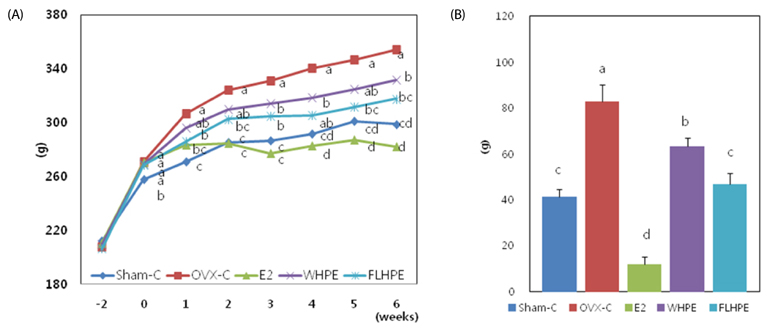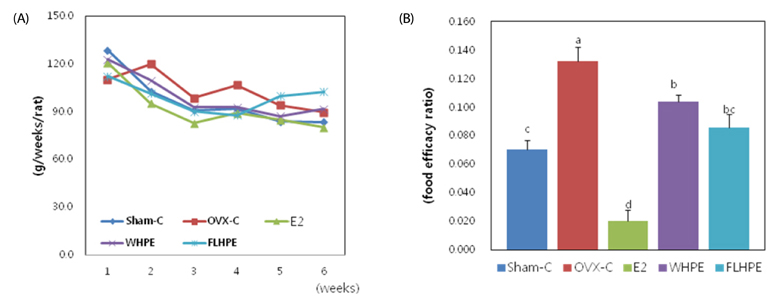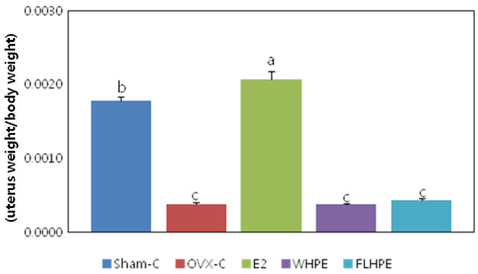Nutr Res Pract.
2014 Jun;8(3):292-296.
Effect of St. John's Wort (Hypericum perforatum) on obesity, lipid metabolism and uterine epithelial proliferation in ovariectomized rats
- Affiliations
-
- 1Department of Food and Nutrition/Research Institute of Human Ecology, Mokpo National University, 1666 Youngsan-ro, Muan, Jeonnam 534-729, Korea. kha@mokpo.ac.kr
- 2Department of Pathology, College of Veterinary Medicine, Kyungpook National University, Daegu 702-701, Korea.
- 3Jeonnam Biofood Technology Center, Naju, Jeonnam 520-330, Korea.
- 4Central Research Institute of Hawon Pharmaceutical, Jangheung-gun, Jeonnam, 529-851, Korea.
Abstract
- BACKGROUND/OBJECTIVES
This study was conducted to assess the potential of St. John's Wort (Hypericum perforatum) to prevent obesity and abnormalities in lipid metabolism induced by ovariectomy in a rat model without stimulatory activity on uterus.
MATERIALS/METHODS
Ovariectomized (OVX) rats were treated for 6 weeks with 70% ethanol extracts of Hypericum perforatum [HPEs: whole plant (WHPE) and flower and leaves (FLHPE)], beta-estradiol-3-benzoate at a dose of 50 microg/kg/day (E2) or vehicle (distilled water).
RESULTS
As expected, OVX increased body weight gain and adiposity and showed higher food efficacy ratio. OVX also increased the serum cholesterol as well as insulin resistance, while reducing uterus weight and uterine epithelial proliferation rate. HPEs (WHPE and FLHPE) showed estrogen-like effect on body weight gain, adipose tissue weight and food efficacy ratio in OVX rats. HPEs prevented hypercholesterolemia induced by OVX more effectively than E2. E2 increased uterus weight and epithelial proliferation rate in OVX rats, while HPEs maintained them at the level of the sham-operated animals.
CONCLUSIONS
Our finding demonstrates that HPEs can be considered as an effective agent to prevent OVX-induced obesity without stimulatory activity on uterus.
Keyword
MeSH Terms
Figure
Reference
-
1. González-Castejón M, Rodriguez-Casado A. Dietary phytochemicals and their potential effects on obesity: a review. Pharmacol Res. 2011; 64:438–455.
Article2. Reaven GM. The metabolic syndrome: time to get off the merry-go-round? J Intern Med. 2011; 269:127–136.
Article3. Toth MJ, Tchernof A, Sites CK, Poehlman ET. Effect of menopausal status on body composition and abdominal fat distribution. Int J Obes Relat Metab Disord. 2000; 24:226–231.
Article4. Richard D. Effects of ovarian hormones on energy balance and brown adipose tissue thermogenesis. Am J Physiol. 1986; 250:R245–R249.
Article5. Wade GN, Gray JM, Bartness TJ. Gonadal influences on adiposity. Int J Obes. 1985; 9:Suppl 1. 83–92.6. Deshaies Y, Dagnault A, Lalonde J, Richard D. Interaction of corticosterone and gonadal steroids on lipid deposition in the female rat. Am J Physiol. 1997; 273:E355–E362.
Article7. Sørensen MB, Rosenfalck AM, Højgaard L, Ottesen B. Obesity and sarcopenia after menopause are reversed by sex hormone replacement therapy. Obes Res. 2001; 9:622–626.
Article8. Gambacciani M, Ciaponi M, Cappagli B, De Simone L, Orlandi R, Genazzani AR. Prospective evaluation of body weight and body fat distribution in early postmenopausal women with and without hormonal replacement therapy. Maturitas. 2001; 39:125–132.
Article9. Hänggi W, Lippuner K, Jaeger P, Birkhäuser MH, Horber FF. Differential impact of conventional oral or transdermal hormone replacement therapy or tibolone on body composition in postmenopausal women. Clin Endocrinol (Oxf). 1998; 48:691–699.
Article10. Gallo D, Zannoni GF, Apollonio P, Martinelli E, Ferlini C, Passetti G, Riva A, Morazzoni P, Bombardelli E, Scambia G. Characterization of the pharmacologic profile of a standardized soy extract in the ovariectomized rat model of menopause: effects on bone, uterus, and lipid profile. Menopause. 2005; 12:589–600.
Article11. Mennini T, Gobbi M. The antidepressant mechanism of Hypericum perforatum. Life Sci. 2004; 75:1021–1027.
Article12. Brenner R, Azbel V, Madhusoodanan S, Pawlowska M. Comparison of an extract of hypericum (LI 160) and sertraline in the treatment of depression: a double-blind, randomized pilot study. Clin Ther. 2000; 22:411–419.
Article13. Schrader E. Equivalence of St John's wort extract (Ze 117) and fluoxetine: a randomized, controlled study in mild-moderate depression. Int Clin Psychopharmacol. 2000; 15:61–68.
Article14. Matthews DR, Hosker JP, Rudenski AS, Naylor BA, Treacher DF, Turner RC. Homeostasis model assessment: insulin resistance and beta-cell function from fasting plasma glucose and insulin concentrations in man. Diabetologia. 1985; 28:412–419.
Article15. Matsuzawa Y, Funahashi T, Kihara S, Shimomura I. Adiponectin and metabolic syndrome. Arterioscler Thromb Vasc Biol. 2004; 24:29–33.
Article16. Heine PA, Taylor JA, Iwamoto GA, Lubahn DB, Cooke PS. Increased adipose tissue in male and female estrogen receptor-alpha knockout mice. Proc Natl Acad Sci U S A. 2000; 97:12729–12734.
Article17. Ribas V, Nguyen MT, Henstridge DC, Nguyen AK, Beaven SW, Watt MJ, Hevener AL. Impaired oxidative metabolism and inflammation are associated with insulin resistance in ERalpha-deficient mice. Am J Physiol Endocrinol Metab. 2010; 298:E304–E319.18. Gao Q, Mezei G, Nie Y, Rao Y, Choi CS, Bechmann I, Leranth C, Toran-Allerand D, Priest CA, Roberts JL, Gao XB, Mobbs C, Shulman GI, Diano S, Horvath TL. Anorectic estrogen mimics leptin's effect on the rewiring of melanocortin cells and Stat3 signaling in obese animals. Nat Med. 2007; 13:89–94.
Article19. Després JP, Lamarche B, Mauriège P, Cantin B, Dagenais GR, Moorjani S, Lupien PJ. Hyperinsulinemia as an independent risk factor for ischemic heart disease. N Engl J Med. 1996; 334:952–957.
Article20. Lombard L, Augustyn MN, Ascott-Evans BH. The metabolic syndrome--pathogenesis, clinical features and management. Cardiovasc J S Afr. 2002; 13:181–186.21. Saglam K, Polat Z, Yilmaz MI, Gulec M, Akinci SB. Effects of postmenopausal hormone replacement therapy on insulin resistance. Endocrine. 2002; 18:211–214.
Article22. Li C, Samsioe G, Borgfeldt C, Bendahl PO, Wilawan K, Aberg A. Low-dose hormone therapy and carbohydrate metabolism. Fertil Steril. 2003; 79:550–555.
Article23. Picard F, Deshaies Y, Lalonde J, Samson P, Labrie C, Bélanger A, Labrie F, Richard D. Effects of the estrogen antagonist EM-652.HCl on energy balance and lipid metabolism in ovariectomized rats. Int J Obes Relat Metab Disord. 2000; 24:830–840.
Article
- Full Text Links
- Actions
-
Cited
- CITED
-
- Close
- Share
- Similar articles
-
- A Case of Mania Associated with Hypericum Perforatum in a Patient with Major Depression
- Hypericum Perforatum Decreased Hippocampus TNF-alpha and Corticosterone Levels with No Effect on Kynurenine/Tryptophan Ratio in Bilateral Ovariectomized Rats
- St. John's Wort (Hypericum perforatum) stimulates human osteoblastic MG-63 cell proliferation and attenuates trabecular bone loss induced by ovariectomy
- Black Cohosh and St. John's Wort (GYNO-Plus(R)) for Climacteric Symptoms
- The efficacy and safety of the combined preparation of Black Cohosh and St. John's wort in menopausal women







